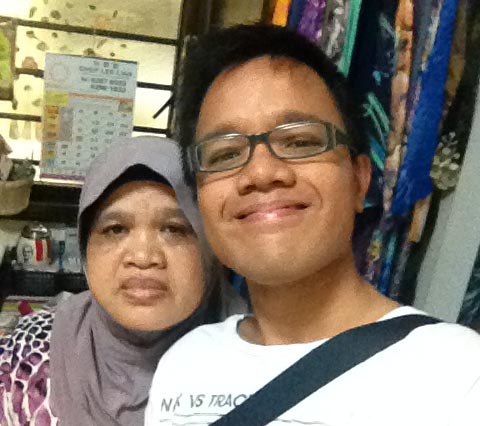Three days ago, my mum freaked out just as I was heading to the bathroom. Holding her phone, she looked at me with horrified eyes and shrieked. : “Azhar… Tolong Mama..!” (Azhar.. Help Mum..!)
I approached her. Nope, her Samsung Xperia phone did not die. Nope, her prepaid card had not depleted.
Her camera app had jumped to another panel and she was worried sick it would be jilted there forever.
That made me chuckle a little (evil, I know) and the problem was solved simply by holding down the camera app and escorting it back to where it should be (the first panel).
Sounds straightforward enough, but not for someone who never knew that the function of holding your finger down on an app is to ‘grab’ it. Throw back ten years ago before the first touchscreen phone, the iPhone, made its debut, pressing down a number on your communication gadget would give an endless string of numerals.
Unnecessary Stress
Famous German-born American painter Hans Hoffman once said,”The ability to simplify means to eliminate the unnecessary so that the necessary may speak.”
When a developer creates a new hardware or software, one of the objectives is to simplify our daily interactions and increase our productivity, in short it aims to improve the quality of our lives. For example, we can now pay our bills via an app, and communicate with our family overseas for free.
Nonetheless, as we have higher expectations on technology and an even greater dependence on it, taking it away, even for a brief moment, would bestow unnecessary stress. The so-called e-topia does not exist.
My Mum is a housewife, so she spends most of her time at home. She has lived to see how technology has evolved, including the cable TV and thermal pot. If you’ve gotten hold onto a MioTV controller, you’d realise the extensive amount of buttons such as Quick Guide and Info.
When my household first received the controller, every time my Mum accidentally pressed on a wrong button by mistake, she would get all stressed out. And if she tried to fix the problem herself, it got worse instead.
We recently bought a new Cornell thermal pot. It is more technologically advanced with customised temperature settings and an auto clean function. There’s even a beep when the water is fully boiled, a feature obviously inspired by the kettle, an unassuming metallic body that has been whistling for hundreds of years.

In 2011, Mike Bradley, a senior lecturer at Middlesex University, once blamed how unnecessarily complicated user interfaces were alienating the elderly in the push for a more tech-savvy global community. The older graphical user interfaces were, compared to today, a lot simpler.
There was a lot less going on, the icons were simpler – with some designed to work in black and white, they tended to be more obvious,” Bradley told PCPro.
I am on Bradley’s side on this; I think my Mum is too. In my opinion, when developers try to serve us consumers better, they tend to invent systems which target our specific needs. For example, in the case of the MioTV controller, I’m sure SingTel was using the Info button to help viewers who wish to know more about a particular program.
Thus, you have a growing umbrella of functions all in one piece of hardware. Some of these functions are useful to the 20-somethings; but to my Mum, they are unnecessary.
Fear of Technology
For a month or so last year, my Mum refused to use the SMS. The reason? She had accidentally sent a text message to another relative when it was intended for me. That one incident made her afraid of sending another text again.
One thing I noticed about my Mum is that she is much more careful when it comes to using a computer or mobile device. For example, my Mum is always wary every time I utilise mobile banking to transfer funds. She reads the newspaper daily and so I’m guessing this cautious approach with technology was cultivated over time.
Also read: In this digital age, there’s something that I still like about physical books, TV and newspaper

Another factor I realised inherent in my Mum’s attitude towards technology is cost. To her, using the house phone is enough. It doesn’t help that my Dad consistently reminds her not to chat on her smartphone for too long lest the bill explodes.
As a result, in general, my Mum would shun away from technologically advanced devices. She was a modern day technophobe.
Introducing the Routine
We react to a scenario in three stages: the cue, routine, and reward. It is a cycle which all of us, young or old, go through daily.
You are sitting in the office, your fingers typing vigorously on the keyboard. Suddenly, a WhatsApp notification pops up (cue). So you pick up your phone, slide to unlock and reply your friend’s query (routine). You are satisfied with helping her and can now continue with your work peacefully (reward).
You just bought a new iPhone 5S. You downloaded all the apps you would normally use or have an account with. You noticed that the apps were disorganised (cue). So you select and hold onto an app, saw all the apps vibrating and proceed to moving them around (routine). You are now relieved and you find your home page more appealing (reward).
My Mum’s big break in overcoming the fear and stress that came with technology was by identifying its routine, which in her case was to make a CHOICE. Honestly speaking, she really doesn’t need to use a smartphone. What was the point since most of her friends prefer talking over the phone anyway?

Nonetheless, my Mum began to be more receptive towards technology once I pitched it as an option, an alternative to keep up with her friends and family. A survey by the Council for Third Age in 2012 showed that half of the 612 respondents used smartphones to stay connected with their friends and family members.
This was the reward to help her get use to a new routine, these were the scenarios I posed to her:
Have something urgent to inform a family member (cue) but afraid to disturb him during work, Mum? Just text him.
One of your grandsons laugh and eager to take a picture of the moment easily, Mum? Capture it on camera or video.
Don’t know what to watch on TV (cue), Mum? Click on the Info button, use the arrow button to navigate and choose your program of choice.
My Mum did all of the above; executing this choice has now become a routine.
Getting Over the Confidence Hurdle
The reward comes next. Not only has my Mum successfully connected with a family member but doing so also makes her more confident to use technological devices.
A survey by Deloitte predicted that smartphone ownership among the over-55s will increase by 40-50% across the developed markets by this year. This group will enjoy the fastest year-on-year rise in smartphone penetration too. Even more interestingly, the study found that the over-55s have become enthusiastic users after picking up their confidence in using smartphones.

I can never promise my Mum that nothing is going to be wrong with her phone, but what I did was to inform her that escaping the distress is easy. It is a long learning process and mistakes can happen anytime. All she had to do was to just keep calm and inform me about the problem.
For simple troubleshooting, such as being in an alien interface on MioTV, my Mum was taught to simply click the ‘Exit’ button. If my Mum were to accidentally send a SMS to the wrong recipient, just simply send an apology.
My 60-year-old Mum is now more confident and enthusiastic to use her smartphone. What better way to celebrate this than with a selfie! Happy Mother’s Day, Mum. 🙂

Also read: 80% of Asian women increase their Internet usage once they become mums


















